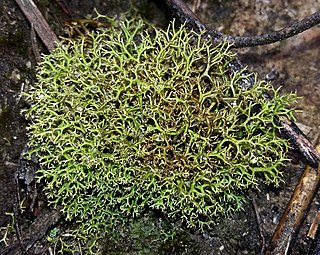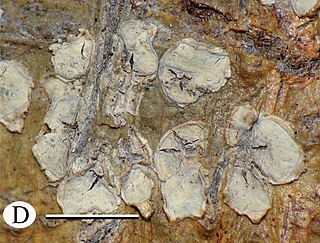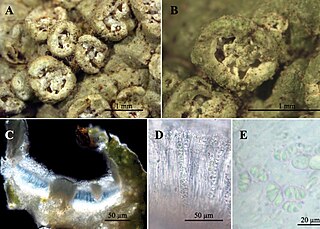
The Graphidaceae are a family of lichen-forming fungi in the order Graphidales. The family contains nearly a hundred genera and more than 2000 species. Although the family has a cosmopolitan distribution, most Graphidaceae species occur in tropical regions, and typically grow on bark.

Cladia is a genus of lichen-forming fungi in the family Cladoniaceae. Cladia species have a crustose or squamulose (scaly) primary thallus and a fruticose, secondary thallus, often referred to as pseudopodetium. The type species of the genus, Cladia aggregata, is widely distributed, occurring in South America, South Africa, Australasia and South-East Asia to southern Japan and India. Most of the other species are found in the Southern Hemisphere.
Aderkomyces thailandicus is a species of corticolous (bark-dwelling), crustose lichen in the family Gomphillaceae. Found in the lower montane rainforests of Thailand, it was described as new to science in 2011.
Graphis marusae is a species of corticolous (bark-dwelling) crustose lichen in the family Graphidaceae. It is found in a relict tropical lowland rainforest in Veracruz, Mexico, growing in exposed understory.

Astrochapsa is a genus of lichen-forming fungi in the subfamily Graphidoideae of the family Graphidaceae. It has 28 species. The genus was circumscribed by Sittiporn Parnmen, Robert Lücking, and H. Thorsten Lumbsch in 2012, with Astrochapsa astroidea assigned as the type species. It was segregated from the genus Chapsa, from which it differs in having a more frequently densely corticate thallus, an apothecial margin that is mostly recurved, and the almost exclusively subdistoseptate, non-amyloid ascospores.
Pseudochapsa is a genus of lichen-forming fungi in the family Graphidaceae. It has 19 species. It was circumscribed in 2012 by Sittiporn Parnmen, Robert Lücking, and Helge Thorsten Lumbsch, with Pseudochapsa dilatata as the type species. Pseudochapsa differs from Chapsa it that its excipulum is typically brown. Additionally, its ascospores are mostly discoseptate and amyloid. The generic name combines the Greek pseudo ("false") with the genus name Chapsa.
Myriochapsa is a genus of corticolous (bark-dwelling), crustose lichens in the subfamily Graphidoidae of the family Graphidaceae. It has three species. The genus was circumscribed in 2013 by Marcela Cáceres, Robert Lücking, and H. Thorsten Lumbsch, with the Brazilian Myriochapsa psoromica assigned as the type species. The generic name combines Myriotrema and Chapsa, referring to the two Graphidaceae genera that it resembles. The main distinguishing characteristics of the new genus are its densely corticate thallus, and the presence of the lichen product psoromic acid. Additionally, its apothecia have wider pores, with differently textured margins. Although originally created as a monotypic genus, Harrie Sipman added two South American species in 2014.
Pseudochapsa lueckingii is a species of corticolous (bark-dwelling), crustose lichen in the family Graphidaceae. It is known only from a single collection in São Paulo, Brazil.
Clandestinotrema is a genus of lichen-forming fungi in the family Graphidaceae. It has 17 species. They typically inhabit montane and cloud forest at higher elevations in the tropics.
Redonographa is a genus of lichen-forming fungi in the monogeneric family Redonographaceae. It has five species.
Gintarasia is a genus of lichen-forming fungi in the family Graphidaceae. It has seven species, all of which are found in Australia. Gintarasia species are corticolous (bark-dwelling), crustose lichens with a thelotremoid form.
Compositrema is a genus of lichen-forming fungi in the family Graphidaceae. It has four species. The genus was circumscribed in 2012 by lichenologists Eimy Rivas Plata, Robert Lücking, and Helge Thorsten Lumbsch, with C. cerebriforme assigned as the type species. The genus is distinguished by its unique, composite pseudostromatic ascomata, which sets it apart from the otherwise similar genus Stegobolus.
Ocellularia vizcayensis is a rare species of corticolous (bark-dwelling) lichen in the family Graphidaceae. It is known from a single collection made in Luzon, Philippines. The lichen thallus is a white, irregularly structured, areolate surface with a layer that includes a photosynthetic partner, both containing large calcium oxalate crystals. Its fruiting bodies are either embedded or protruding, round, with very narrow openings, and contain large, oblong, colorless spores that turn violet-blue when stained with iodine.
Pycnotrema is a small genus of lichen-forming fungi in the family Graphidaceae. Its two species are characterised by their small, rounded apothecial pores.

Glaucotrema is a genus of lichen-forming fungi in the family Graphidaceae. It has five species.
Crutarndina is a monotypic fungal genus in the family Graphidaceae. It contains the single species Crutarndina petractoides, a corticolous (bark-dwelling), crustose lichen.
Pseudotopeliopsis is a genus of lichen-forming fungi in the family Graphidaceae. It has two species.

Mangoldia is a genus of lichen-forming fungi in the subfamily Graphidoideae of the family Graphidaceae. It contains four species of corticolous (bark-dwelling) script lichens.
Melanotopelia is a genus of lichen-forming fungi in the family Graphidaceae. It has four species of corticolous (bark-dwelling), crustose lichens. This genus includes species characterised by dark pigmentation in their exciple, non-amyloid ascospores, and specific secondary metabolites.
Corticorygma is a monotypic fungal genus in the subfamily Graphidoideae of the family Graphidaceae. It contains a single species, the corticolous (bark-dwelling) crustose lichen Corticorygma stellatum. This script lichen is found in the shaded understory of rainforests in the Brazilian states of Rondônia and Paraná.




